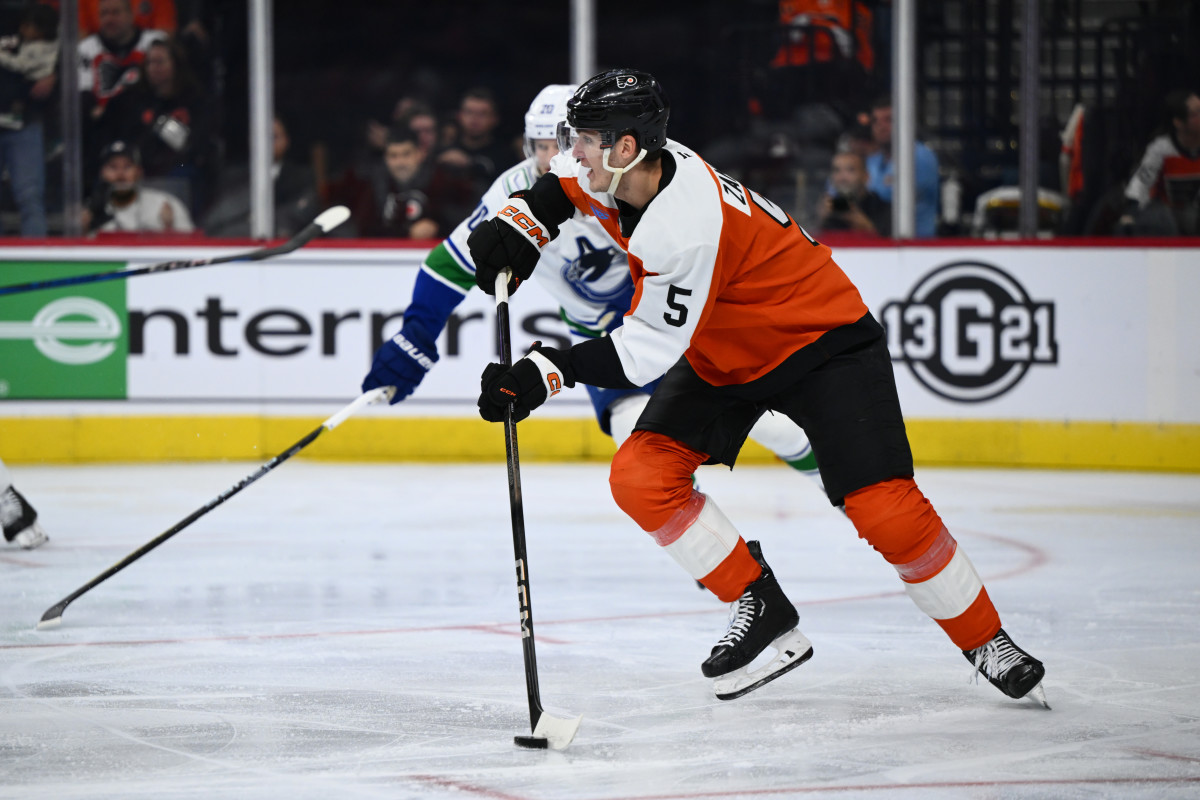Touted as a promising young blueliner with some good size and puck-moving ability, Egor Zamula has struggled to find his footing, becoming more of a liability than an asset for a Flyers team desperate for some stability.

The start of the 2024-25 season has not been kind to Philadelphia Flyers defenseman Egor Zamula.
Touted as a promising young blueliner with some good size and puck-moving ability, Zamula has struggled to find his footing, becoming more of a liability than an asset for a Flyers team desperate for some stability.
While the season is still young, Zamula's early performances have raised concerns about his readiness to handle significant responsibilities in the lineup.

One of the most glaring issues with Zamula's game this season has been his inability to effectively quarterback the second powerplay unit. The Flyers' powerplay, already ranked at the bottom of the league for the past few seasons, has been hampered by an inability to generate sustained offensive pressure.
As the defenseman tasked with running the second unit from the blue line, Zamula has not yet demonstrated the poise, vision, or decision-making necessary to succeed in that role.
One of the most important skills for a powerplay quarterback is distributing the puck efficiently while maintaining control at the blue line, but in this role, Zamula has struggled with his passing accuracy. He often misfires on critical plays or telegraphing his intentions, making it easier for the penalty killers to intercept passes or pressure him into mistakes.
Additionally, Zamula's shot has been ineffective at generating danger. The Flyers need their defensemen to get pucks through traffic and on net to create scoring opportunities off rebounds or deflections. So far, however, Zamula's shots have lacked the precision and velocity to beat goaltenders cleanly or generate second chances.
His hesitancy to take open shots or his tendency to aim into the legs of defenders has neutralized the Flyers' second powerplay unit, leaving them unable to capitalize on man-advantage situations.
Zamula's difficulties extend beyond the powerplay and into his even-strength play, particularly in his defensive pairing with Rasmus Ristolainen.
While both players bring different skill sets to the table—Zamula as a puck-moving defenseman and Ristolainen as a more physical, stay-at-home type—their partnership has been problematic. The duo has been prone to defensive breakdowns, and their lack of chemistry has contributed to high-danger scoring chances for opposing teams.
One of the key issues with this pairing is their inability to communicate and cover each other effectively. When playing alongside a more defensively oriented partner like Ristolainen, Zamula is expected to be the puck-carrier, making clean zone exits and neutral zone passes to drive play up the ice.
However, his decision-making under pressure has often been suspect, resulting in turnovers or poor clearing attempts that leave the Flyers vulnerable to extended shifts in their own zone. When Zamula struggles to transition the puck effectively, it puts additional pressure on Ristolainen to defend in high-risk situations, something that hasn't played to their strengths as a unit.
It's important to acknowledge that Ristolainen's own limitations exacerbate the challenges Zamula faces. While he brings a physical edge, Ristolainen's struggles with injuries off the ice, in addition to positioning discipline in his own zone on the ice, make it difficult for him to compensate for Zamula's errors (which tend to be with his own positioning and gap control, having been caught out of position on multiple occasions, which have led to odd-man rushes or leaving the front of the net exposed).

This lack of awareness has contributed to the Flyers giving up too many quality chances, and Zamula's inability to consistently make the right reads has put undue pressure on the rest of the defensive corps and the goaltending tandem of Sam Ersson and Ivan Fedotov.
In turn, this pairing lacks a stabilizing presence, and when both players are on the ice, the Flyers have been far too easy to break down defensively.
For Zamula to turn his season around, several adjustments need to be made. First and foremost, he must simplify his game, particularly when under pressure. Rather than trying to make the perfect play, he should focus on making smart, efficient decisions, whether it's a quick outlet pass or getting the puck deep to relieve pressure.
Improving his pass accuracy and decision-making on the powerplay will also help the Flyers convert on the man advantage (although it wouldn't be a bad idea to replace him with Cam York for the time being on the PP2 unit).
And although the line shuffling has proven to be an issue for the offense, it's necessary for the coaching staff to start thinking about a new partner for Zamula.
He could benefit from playing with a more experienced, steady partner who can cover for his defensive lapses while allowing him to focus on developing his offensive game. (The obvious choice here would be Erik Johnson, who was a placeholder for Nick Seeler in a pairing with Jamie Drysdale.)
Alternatively, reducing his minutes until he can regain confidence and refine his play might help alleviate the pressure he faces as a young defenseman stepping into a bigger role at the NHL level.
But if Zamula cannot stabilize his game soon, the Flyers may need to rethink his role in the lineup and to prevent further damage to their defensive structure and powerplay efficiency. Developing a young defenseman takes time, but in the NHL, every mistake counts, and the Flyers can ill afford to continue seeing the same liabilities night after night.



